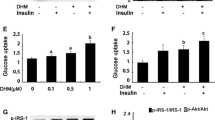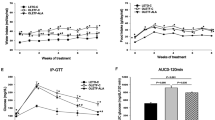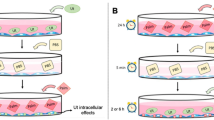Abstract
The combination of sarcopenia and obesity (i.e., sarcopenic obesity) is more strongly associated with disability and metabolic/cardiovascular diseases than obesity or sarcopenia alone. Therefore, countermeasures that simultaneously suppress fat gain and muscle atrophy to prevent an increase in sarcopenic obesity are warranted. The aim of this study was to investigate the simultaneous effects of fucoxanthinol (FXOH) on fat loss in mature adipocytes and the inhibition of atrophy and loss in myotubes induced by oxidative stress. C2C12 myotubes were treated with FXOH for 24 h and further incubated with hydrogen peroxide (H2O2) for 24 h. The area of myosin heavy chain-positive myotubes and the ROS concentration were measured. Mature 3T3-L1 adipocytes were treated with FXOH for 72 h. The triacylglycerol (TG) content and glycerol and fatty acid (FA) release were biochemically measured. The myotube area was smaller in H2O2-treated cells than that in control cells. However, FXOH protected against the H2O2-induced decreases in myotube area. Further, the ROS concentration was significantly higher in the FXOH-treated cells compared with that in the control cells, although it was significantly lower than that in the H2O2-treated cells. On the other hand, in the mature adipocytes, the TG content was significantly decreased by FXOH treatment compared to that in the control. Moreover, FXOH treatment significantly increased glycerol and FA release compared with that of the control. These results suggest that FXOH inhibits H2O2-induced atrophy and loss in myotubes and activates lipolysis and decreases the TG content in mature adipocytes. Accordingly, FXOH has the potential to exert anti-sarcopenic obesity effects.




Similar content being viewed by others
References
Roubenoff R (2000) Sarcopenic obesity: does muscle loss cause fat gain? Lessons from rheumatoid arthritis and osteoarthritis. Ann N Y Acad Sci 904:553–557. https://doi.org/10.1111/j.1749-6632.2000.tb06515.x
Morley JE, Baumgartner RN, Roubenoff R, Mayer J, Nair KS (2001) Sarcopenia. J Lab Clin Med 137:231–243. https://doi.org/10.1067/mlc.2001.113504
Zamboni M, Mazzali G, Fantin F, Rossi A, Francesco VD (2008) Sarcopenic obesity: a new category of obesity in the elderly. Nutr Metab Cardiovasc Dis 18:388–395. https://doi.org/10.1016/j.numecd.2007.10.002
Gregor MF, Hotamisligil GS (2011) Inflammatory mechanisms in obesity. Annu Rev Immunol 29:415–445. https://doi.org/10.1146/annurev-immunol-031210-101322
Kim TN, Yang SJ, Yoo HJ, Lim KI, Kang HJ, Song W, Seo JA, Kim SG, Kim NH, Baik SH, Choi DS, Choi KM (2009) Prevalence of sarcopenia and sarcopenic obesity in Korean adults: the Korean sarcopenic obesity study. Int J Obes 33:885–892. https://doi.org/10.1038/ijo.2009.130
Hashimoto T, Ozaki Y, Taminato M, Das SK, Mizuno M, Yoshimura K, Maoka T, Kanazawa K (2009) The distribution and accumulation of fucoxanthin and its metabolites after oral administration in mice. Br J Nutr 102:242–248. https://doi.org/10.1017/s0007114508199007
Hosokawa M, Miyashita T, Nishikawa S, Emi S, Tsukui T, Beppu F, Okada T, Miyashita K (2010) Fucoxanthin regulates adipocytokine mRNA expression in white adipose tissue of diabetic/obese KK-Ay mice. Arch Biochem Biophys 504:17–25. https://doi.org/10.1016/j.abb.2010.05.031
Yim MJ, Hosokawa M, Mizushina Y, Yoshida H, Saito Y, Miyashita K (2011) Suppressive effects of amarouciaxanthin A on 3T3-L1 adipocyte differentiation through down-regulation of PPARgamma and C/EBPalpha mRNA expression. J Agric Food Chem 59:1646–1652. https://doi.org/10.1021/jf103290f
Rebello CJ, Greenway FL, Johnson WD, Ribnicky D, Poulev A, Stadler K, Coulter AA (2017) Fucoxanthin and its metabolite fucoxanthinol do not induce browning in human adipocytes. J Agric Food Chem 65:10915–10924. https://doi.org/10.1021/acs.jafc.7b03931
Kang SI, Shin HS, Kim HM, Yoon SA, Kang SW, Kim JH, Ko HC, Kim SJ (2012) Petalonia binghamiae extract and its constituent fucoxanthin ameliorate high-fat diet-induced obesity by activating AMP-activated protein kinase. J Agric Food Chem 60:3389–3395. https://doi.org/10.1021/jf2047652
Sheard PW, Anderson RD (2012) Age-related loss of muscle fibres is highly variable amongst mouse skeletal muscles. Biogerontology 13:157–167. https://doi.org/10.1007/s10522-011-9365-0
Wilkinson DJ, Piasecki M, Atherton PJ (2018) The age-related loss of skeletal muscle mass and function: measurement and physiology of muscle fibre atrophy and muscle fibre loss in humans. Ageing Res Rev 47:123–132. https://doi.org/10.1016/j.arr.2018.07.005
Dirks AJ, Leeuwenburgh C (2005) The role of apoptosis in age-related skeletal muscle atrophy. Sport Med 35:473–483. https://doi.org/10.2165/00007256-200535060-00002
Siu PM, Wang Y, Alway SE (2009) Apoptotic signaling induced by H2O2-mediated oxidative stress in differentiated C2C12 myotubes. Life Sci 84:468–481. https://doi.org/10.1016/j.lfs.2009.01.014
Escobedo J, Pucci AM, Koh TJ (2004) HSP25 protects skeletal muscle cells against oxidative stress. Free Radic Biol Med 37:1455–1462. https://doi.org/10.1016/j.freeradbiomed.2004.07.024
Meng S-J, Yu L-J (2010) Oxidative stress, molecular inflammation and sarcopenia. Int J Mol Sci 11:1509–1526. https://doi.org/10.3390/ijms11041509
Ogawa M, Kariya Y, Kitakaze T, Yamaji R, Harada N, Sakamoto T, Hosotani K, Nakano Y, Inui H (2013) The preventive effect of beta-carotene on denervation-induced soleus muscle atrophy in mice. Br J Nutr 109:1349–1358. https://doi.org/10.1017/s0007114512003297
Sachindra NM, Sato E, Maeda H, Hosokawa M, Niwano Y, Kohno M, Miyashita K (2007) Radical scavenging and singlet oxygen quenching activity of marine carotenoid fucoxanthin and its metabolites. J Agric Food Chem 55:8516–8522. https://doi.org/10.1021/jf071848a
Hashimoto T, Yokokawa T, Endo Y, Iwanaka N, Higashida K, Taguchi S (2013) Modest hypoxia significantly reduces triglyceride content and lipid droplet size in 3T3-L1 adipocytes. Biochem Biophys Res Commun 440:43–49. https://doi.org/10.1016/j.bbrc.2013.09.034
Oishi Y, Tsukamoto H, Yokokawa T, Hirotsu K, Shimazu M, Uchida K, Tomi H, Higashida K, Iwanaka N, Hashimoto T (2015) Mixed lactate and caffeine compound increases satellite cell activity and anabolic signals for muscle hypertrophy. J Appl Physiol 118:742–749. https://doi.org/10.1152/japplphysiol.00054.2014
Hwang SY, Kang YJ, Sung B, Kim M, Kim DH, Lee Y, Yoo MA, Kim CM, Chung HY, Kim ND (2015) Folic acid promotes the myogenic differentiation of C2C12 murine myoblasts through the Akt signaling pathway. Int J Mol Med 36:1073–1080. https://doi.org/10.3892/ijmm.2015.2311
Camperi A, Pin F, Costamagna D, Penna F, Menduina ML, Aversa Z, Zimmers T, Verzaro R, Fittipaldi R, Caretti G, Baccino FM, Muscaritoli M, Costelli P (2017) Vitamin D and VDR in cancer cachexia and muscle regeneration. Oncotarget 8:21778–21793. https://doi.org/10.18632/oncotarget.15583
Sakane H, Akasaki K (2018) The major lysosomal membrane proteins LAMP-1 and LAMP-2 participate in differentiation of C2C12 myoblasts. Biol Pharm Bull 41:1186–1193. https://doi.org/10.1248/bpb.b17-01030
Hashimoto T, Kambara N, Nohara R, Yazawa M, Taguchi S (2004) Expression of MHC-beta and MCT1 in cardiac muscle after exercise training in myocardial-infarcted rats. J Appl Physiol 97:843–851. https://doi.org/10.1152/japplphysiol.01193.2003
Hashimoto T, Segawa H, Okuno M, Kano H, Hamaguchi HO, Haraguchi T, Hiraoka Y, Hasui S, Yamaguchi T, Hirose F, Osumi T (2012) Active involvement of micro-lipid droplets and lipid-droplet-associated proteins in hormone-stimulated lipolysis in adipocytes. J Cell Sci 125:6127–6136. https://doi.org/10.1242/jcs.113084
Poljsak B, Suput D, Milisav I (2013) Achieving the balance between ROS and antioxidants: when to use the synthetic antioxidants. Oxid Med Cell Longev. https://doi.org/10.1155/2013/956792
B. Poljšak, I. Milisav (2013) Aging, oxidative stress and antioxidants. In: JA Morales-González (ed), Oxidative stress and chronic degenerative diseases—a role for antioxidants. IntechOpen. pp 331–356. https://dx.doi.org/10.5772/51609
Shibaguchi T, Yamaguchi Y, Miyaji N, Yoshihara T, Naito H, Goto K, Ohmori D, Yoshioka T, Sugiura T (2016) Astaxanthin intake attenuates muscle atrophy caused by immobilization in rats. Physiol Rep 4:e12885. https://doi.org/10.14814/phy2.12885
Nomura T, Kikuchi M, Kubodera A, Kawakami Y (1997) Proton-donative antioxidant activity of fucoxanthin with 1,1-diphenyl-2-picrylhydrazyl (DPPH). Biochem Mol Biol Int 42:361–370. https://doi.org/10.1080/15216549700202761
Pangestuti R, Kim S-K (2011) Neuroprotective effects of marine algae. Mar Drugs 9:803–818. https://doi.org/10.3390/md9050803
Wang X, Cui YJ, Qi J, Zhu MM, Zhang TL, Cheng M, Liu SM, Wang GC (2018) Fucoxanthin exerts cytoprotective effects against hydrogen peroxide-induced oxidative damage in L02 cells. Biomed Res Int 2018:1085073. https://doi.org/10.1155/2018/1085073
Sandri M, Sandri C, Gilbert A, Skurk C, Calabria E, Picard A, Walsh K, Schiaffino S, Lecker SH, Goldberg AL (2004) Foxo transcription factors induce the atrophy-related ubiquitin ligase atrogin-1 and cause skeletal muscle atrophy. Cell 117:399–412. https://doi.org/10.1016/s0092-8674(04)00400-3
Li YP, Chen Y, Li AS, Reid MB (2003) Hydrogen peroxide stimulates ubiquitin-conjugating activity and expression of genes for specific E2 and E3 proteins in skeletal muscle myotubes. Am J Physiol Cell Physiol 285:C806–C812. https://doi.org/10.1152/ajpcell.00129.2003
Servais S, Letexier D, Favier R, Duchamp C, Desplanches D (2007) Prevention of unloading-induced atrophy by vitamin E supplementation: links between oxidative stress and soleus muscle proteolysis? Free Radic Biol Med 42:627–635. https://doi.org/10.1016/j.freeradbiomed.2006.12.001
Haramizu S, Asano S, Butler DC, Stanton DA, Hajira A, Mohamed JS, Alway SE (2017) Dietary resveratrol confers apoptotic resistance to oxidative stress in myoblasts. J Nutr Biochem 50:103–115. https://doi.org/10.1016/j.jnutbio.2017.08.008
Liu L, Cash TP, Jones RG, Keith B, Thompson CB, Simon MC (2006) Hypoxia-induced energy stress regulates mRNA translation and cell growth. Mol Cell 21:521–531. https://doi.org/10.1016/j.molcel.2006.01.010
Hardie DG (2008) AMPK and raptor: matching cell growth to energy supply. Mol Cell 30:263–265. https://doi.org/10.1016/j.molcel.2008.04.012
Maeda H, Hosokawa M, Sashima T, Takahashi N, Kawada T, Miyashita K (2006) Fucoxanthin and its metabolite, fucoxanthinol, suppress adipocyte differentiation in 3T3-L1 cells. Int J Mol Med 18:147–152. https://doi.org/10.3892/ijmm.18.1.147
Hashimoto T, Sato K, Iemitsu M (2013) Exercise-inducible factors to activate lipolysis in adipocytes. J Appl Physiol 1985(115):260–267. https://doi.org/10.1152/japplphysiol.00427.2013
Wakil SJ, Abu-Elheiga LA (2009) Fatty acid metabolism: target for metabolic syndrome. J Lipid Res 50:S138–S143. https://doi.org/10.1194/jlr.R800079-JLR200
Lodhi IJ, Yin L, Jensen-Urstad AP, Funai K, Coleman T, Baird JH, El Ramahi MK, Razani B, Song H, Fu-Hsu F, Turk J, Semenkovich CF (2012) Inhibiting adipose tissue lipogenesis reprograms thermogenesis and PPARgamma activation to decrease diet-induced obesity. Cell Metab 16:189–201. https://doi.org/10.1016/j.cmet.2012.06.013
Viollet B, Andreelli F (2011) AMP-activated protein kinase and metabolic control. Handb Exp Pharmacol. https://doi.org/10.1007/978-3-642-17214-4_13
Narkar VA, Downes M, Yu RT, Embler E, Wang Y-X, Banayo E, Mihaylova MM, Nelson MC, Zou Y, Juguilon H, Kang H, Shaw RJ, Evans RM (2008) AMPK and PPARdelta agonists are exercise mimetics. Cell 134:405–415. https://doi.org/10.1016/j.cell.2008.06.051
Acknowledgements
This study was supported by the Grant-in-Aid for Scientific Research from the Japanese Ministry of Education, Culture, Sports, Science, and Technology (#26702029 and #18K19762 to TH) and funding from TOYO INSTITUTE of FOOD TECHNOLOGY.
Author information
Authors and Affiliations
Corresponding author
Ethics declarations
Conflict of interest
The authors have no conflicts of interest to declare.
Additional information
Publisher's Note
Springer Nature remains neutral with regard to jurisdictional claims in published maps and institutional affiliations.
Rights and permissions
About this article
Cite this article
Yoshikawa, M., Hosokawa, M., Miyashita, K. et al. Fucoxanthinol attenuates oxidative stress-induced atrophy and loss in myotubes and reduces the triacylglycerol content in mature adipocytes. Mol Biol Rep 47, 2703–2711 (2020). https://doi.org/10.1007/s11033-020-05369-8
Received:
Accepted:
Published:
Issue Date:
DOI: https://doi.org/10.1007/s11033-020-05369-8




